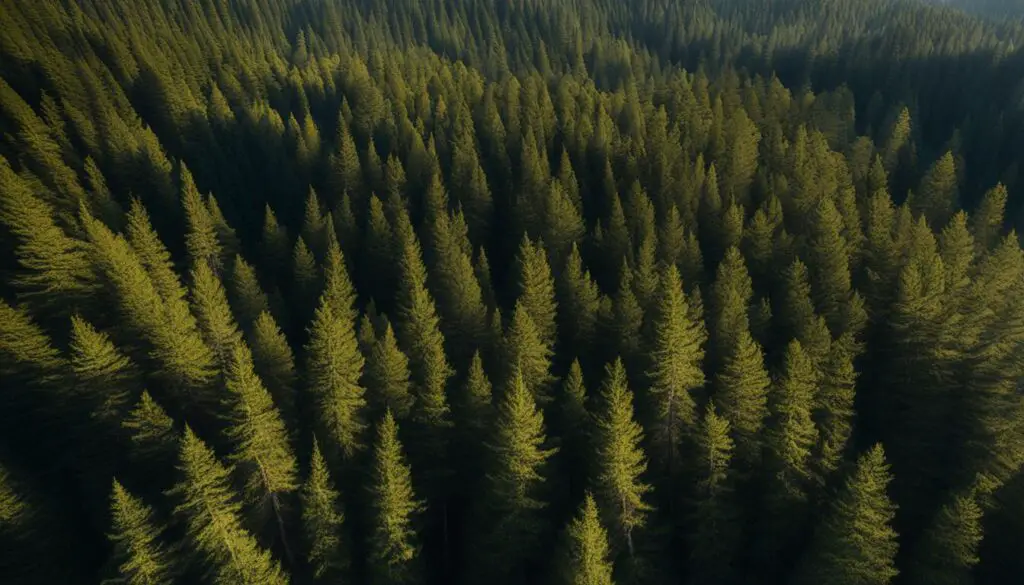When it comes to majestic trees, pine trees are among the most iconic. Have you ever wondered just how tall these impressive trees can grow? In this article, we will explore the average height and maximum height of pine trees, as well as the factors that can influence their growth.
Key Takeaways:
- Pine trees can reach varying heights, ranging from as short as 4 feet to over 150 feet.
- The height of a pine tree depends on factors such as the species, growth rate, and environmental conditions.
- Proper care and favorable growing conditions can help pine trees reach their full potential height.
- Some of the tallest pine tree species include the white pine and the slash pine.
- Understanding the height range of different pine tree species can help in choosing the right tree for your landscaping needs.
Factors Affecting Pine Tree Height
Pine tree height can be influenced by various factors. The species of the pine tree plays a significant role in determining its maximum height. For example, the mugo pine is naturally dwarf and reaches heights of only 2 to 5 feet. On the other hand, species like the white pine have the potential to grow over 150 feet tall. The growth rate of a pine tree also impacts its final height. Faster-growing species, such as the spruce pine, can reach heights of 50 to 90 feet.
Environmental conditions also play a crucial role in the height of a pine tree. Sunlight availability is essential for photosynthesis and overall growth. Different species have varying requirements for sunlight, with some thriving in full sun and others tolerating partial shade. Soil fertility and moisture availability are other key factors affecting pine tree height. Pine trees prefer well-drained soil with good fertility, as poor soil conditions can stunt growth potential.
“The species and growth rate of the pine tree, along with environmental factors such as sunlight, soil fertility, and moisture availability, are key determinants of its height,” explained Dr. Jane Peterson, an expert in botany and tree physiology.
Factors Affecting Pine Tree Height
| Factor | Description |
|---|---|
| Species | The species of a pine tree determines its maximum height. Some species are naturally dwarf while others can grow very tall. |
| Growth Rate | Pine trees with faster growth rates tend to reach greater heights compared to slower-growing species. |
| Environmental Conditions | Sunlight availability, soil fertility, and moisture levels influence the growth potential and height of pine trees. |
Understanding the factors that affect pine tree height is crucial for proper cultivation and management. By considering the species, growth rate, and environmental conditions, tree enthusiasts and arborists can create suitable growing conditions to help pine trees reach their full potential.
Different Pine Tree Species and Their Heights
When it comes to pine trees, there is a vast variety of species, each with its own characteristic height. Let’s explore some examples of different pine tree species and their respective heights.
Mugo Pine
The Mugo Pine, a dwarf cultivar, is known for its compact size. It typically reaches a height range of 2 to 5 feet. This makes it a popular choice for landscaping projects where small, low-maintenance trees are desired.
Virginia Pines (Scrub Pines)
Growing to a height of 15 to 40 feet, Virginia Pines, also known as Scrub Pines, are medium-sized pine trees. They are commonly found in the eastern United States, offering a natural and rustic aesthetic to the landscape.
Spruce Pines
Spruce Pines have a relatively taller stature, reaching heights of 50 to 90 feet. These medium-sized pines are known for their soft needles and cone-like shape, adding elegance to any outdoor setting.
Longleaf Pines
Longleaf Pines also fall within the medium-sized range, with a height range of 55 to 80 feet. These majestic trees are prevalent in the southeastern United States and are characterized by their long, slender needles.
White Pine
One of the tallest pine tree species, the White Pine can soar to heights of over 150 feet. These towering trees exhibit graceful branches and long, slender needles. They are often used as a centerpiece in landscaped areas or as Christmas trees due to their impressive height.
Slash Pine
The Slash Pine is another tall species, reaching a height of 100 feet. These pines are renowned for their rapid growth rate and are commonly found in the southeastern United States, adding a touch of grandeur to the surrounding landscape.
These are just a few examples of the wide range of pine tree species and their respective heights. Whether you’re looking for a small decorative tree or a towering centerpiece, there’s a pine tree species to suit your specific needs.

Care for Pine Tree Growth
Providing excellent care for pine trees is essential for promoting healthy growth and maximizing their potential height. To ensure optimal growth, it is important to consider several factors:
- Planting Location: Choose an area that receives full sun for the majority of the day. Pine trees thrive in sunlight and require a minimum of 6 hours of direct sunlight daily for optimal growth.
- Soil Conditions: Pine trees prefer well-drained soil with good fertility. Before planting, ensure the soil is loose and free of any debris or rocks. It should also have adequate drainage to prevent waterlogging, which can hinder growth.
- Moisture Management: Adequate moisture is crucial for pine tree growth. While they are relatively drought-tolerant once established, regular watering during dry periods will help promote healthy growth. Water the trees deeply, allowing the water to reach the roots.
- Mulching: Adding a layer of organic mulch around the base of the pine tree can help retain moisture, regulate soil temperature, and prevent weed growth. Apply a layer of mulch around 2-4 inches thick, keeping it a few inches away from the trunk to avoid moisture build-up.
“The growth rate of pine trees can vary significantly depending on various factors such as species, age, environmental conditions, and overall health.”
It is important to note that different species of pine trees have varying growth rates. Some species may grow faster than others, while some can take longer to reach their maximum height. Consulting with a local arborist or horticulturist can provide valuable insights into the growth habits and rates of specific pine tree species in your region.
By providing proper care, maintaining optimal growing conditions, and understanding the growth rate of your chosen pine tree species, you can help ensure healthy growth and maximize the tree’s potential height.
Common Pine Tree Height Range
Pine trees exhibit a wide range of heights depending on the species. Let’s explore some examples of common height ranges for different types of pine trees.
| Pine Tree Species | Height Range |
|---|---|
| Mugo Pine | 2 to 5 feet |
| Virginia Pine | 15 to 40 feet |
| Spruce Pine | 50 to 90 feet |
| Longleaf Pine | 55 to 80 feet |
| White Pine | Over 150 feet |
| Slash Pine | 100 feet or more |
As you can see, dwarf pine trees like the Mugo Pine typically reach heights of 2 to 5 feet, while shorter varieties such as the Virginia Pine have a height range of 15 to 40 feet. Medium-sized pines like the Spruce Pine and Longleaf Pine can grow between 50 to 90 feet. Meanwhile, tall pine trees, including the White Pine and Slash Pine, soar to heights of 100 feet or more.

Understanding the height range of different pine tree species can help you select the right tree for your landscaping needs. Whether you’re aiming for a small accent tree or a majestic centerpiece, knowing the potential height of a pine tree species is essential for achieving your desired aesthetic and functional outcomes.
Conclusion
In conclusion, pine trees have a remarkable range of growth, with heights that can range from as short as 4 feet to well over 150 feet. The height of a pine tree is determined by various factors, including the species, growth rate, and environmental conditions.
Providing proper care and creating optimal growing conditions are crucial for ensuring that pine trees reach their full potential height. This includes planting them in areas with sufficient sunlight, well-drained soil, and adequate moisture. Adding mulch can help retain water and suppress weed growth, promoting healthy pine tree growth.
Understanding the height range of different pine tree species is essential when selecting the right tree for landscaping or other purposes. Some species, like the mugo pine, are naturally small, while others, such as the white pine, can grow to towering heights. By considering the specific requirements and height potential of each species, individuals can make informed decisions when incorporating pine trees into their outdoor spaces.
FAQ
How tall do pine trees grow?
Pine trees can grow to varying heights, ranging from as short as 4 feet to over 150 feet, depending on the species, growth rate, and environmental conditions.
What factors affect pine tree height?
The height of pine trees can be influenced by factors such as the species of the tree, its growth rate, and environmental conditions including sunlight, soil fertility, and moisture availability.
What are some examples of tall pine tree species?
Some of the tallest pine tree species include the white pine, which can grow over 150 feet tall, and the slash pine, which reaches a height of 100 feet.
How can I care for pine tree growth?
To promote healthy growth, pine trees should be planted in areas exposed to full sun, in well-drained soil with good fertility. Adequate moisture and the addition of mulch can also help retain water and prevent weed growth.
What is the common height range for pine trees?
Pine trees can have a wide height range depending on the species. For example, dwarf pine trees like the mugo pine typically reach heights of 2 to 5 feet, while tall pine trees like the slash pine can reach heights of 100 feet or more.
How tall do pine trees generally grow?
On average, pine trees can grow anywhere from 4 feet to over 150 feet, depending on the species, growth rate, and environmental conditions.

